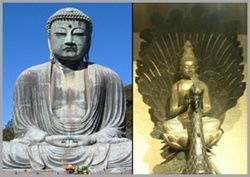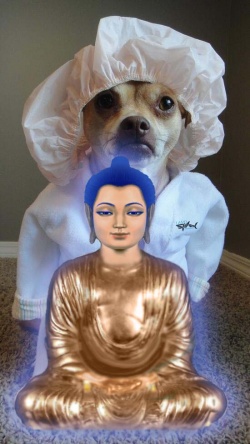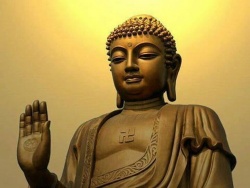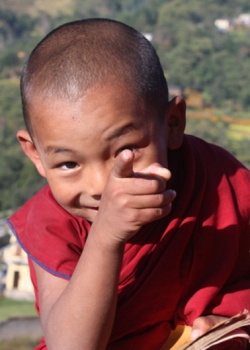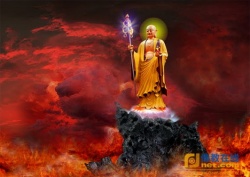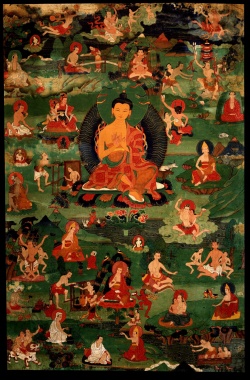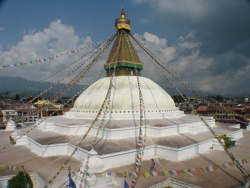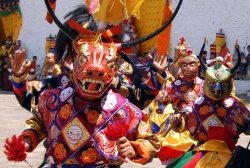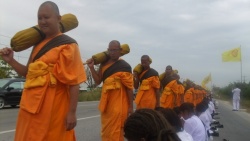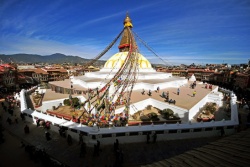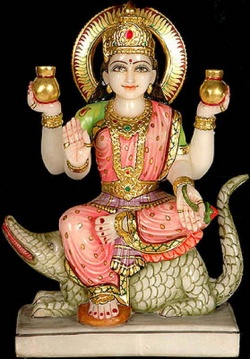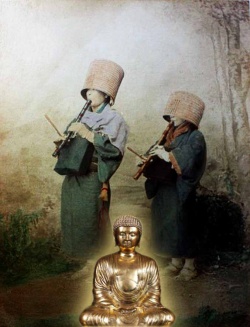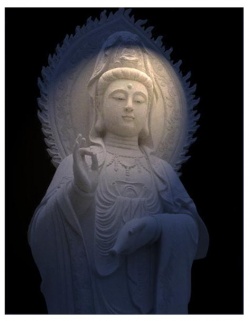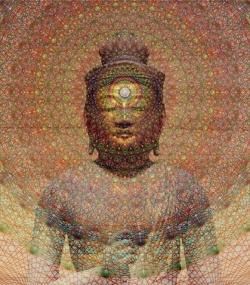Tibetan Script
The Tibetan alphabet is an abugida of Indic origin used to write the Tibetan language as well as the Dzongkha language, Denzongkha, Ladakhi language and sometimes the Balti language.
The printed form of the alphabet is called uchen script (Wylie: dbu-can; "with a head") while the hand-written cursive form used in everyday writing is called umê (Wylie: dbu-med; "headless").
The alphabet is very closely linked to a broad ethnic Tibetan identity. Besides Tibet, it has also been used for Tibetan languages in Bhutan, India, Nepal, and Pakistan.
The Tibetan alphabet is ancestral to the Limbu alphabet, the Lepcha alphabet, and the multilingual 'Phags-pa script.
The Tibetan alphabet is romanized in a variety of ways. This article employs the Wylie transliteration system.
History
The creation of the Tibetan alphabet is attributed to Thonmi Sambhota of the mid-7th century.
Tradition holds that Thonmi Sambhota, a minister of Songtsen Gampo (569-649), was sent to India to study the art of writing, and upon his return introduced the alphabet. The form of the letters is based on an Indic alphabet of that period.
Three orthographic standardizations were developed.
The most important, an official orthography aimed to facilitate the translation of Buddhist scriptures, emerged during the early 9th century.
Standard orthography has not altered since then, while the spoken language has changed by, for example, losing complex consonant clusters.
As a result, in all modern Tibetan dialects, in particular in the Standard Tibetan of Lhasa, there is a great divergence between spelling (which reflects the 9th-century contradictory spoken Tibetan) and pronunciation.
This divergence is the basis of an argument in favour of spelling reform, to write Tibetan "as it is pronounced", for example, writing "Kagyu" instead of "Bka'-rgyud". In contrast, the pronunciation of the Balti, Ladakhi and Burig languages adheres more closely to the archaic spelling.
Description
The Tibetan alphabet has 30 consonants, sometimes known as radicals, which are the basis of the script.
Polychrome text left of center is the primary mantra of Tibetan Buddhism, Sanskrit O? Ma?i Padme H?? (Wylie: oMmanipad+mehU~M).
Monochrome text right of center reads Sanskrit "O? Vajrasattva H?m" (Wylie: oM badzrasatwa hUM), an invocation to the embodiment of primeval purity.
As in other Indic scripts, each consonant letter assumes an inherent /a/.
However, a unique aspect of the Tibetan script is that the consonants can be written either as radicals, or they can be written in other forms, such as superscripts and subscripts.
The superscript position above a radical is reserved for the consonants r, l, and s, while the subscript position under a radical is for the consonants y, r, l, and w.
To understand how this works, one can look at the radical "ka" and see what happens when it becomes "kra" or "rka".
In both cases, the symbol for "ka" is used, but when the r is in the middle of the consonant and vowel, it is added as a subscript.
On the other hand, when the r comes before the consonant and vowel, it is added as a superscript. R actually changes form when it is above most other consonants; thus rka.
However, an exception to this is the cluster rnya. Similarly, the consonants w, r, and y change form when they are beneath other consonants; thus kwa; kra; kya.
Besides being written as subscripts and superscripts, some consonants can also be placed in prescript, postscript, or post-postscript positions.
For instance, the consonants g, d, b, m, and ’a ("’a chung") can be used in the prescript position to the left of other radicals, while the position after a radical (the postscript position), can be held by the ten consonants g, n, b, d, m, ’a, r, n?, s, and l.
The third position, the post-postscript position, is solely for the consonants d and s.
The vowels used in the alphabet are a, i, u, e, and o.
While the vowel a is included in each consonant or radical, the other vowels are indicated by marks; thus ka, ki, ku, ke, ko. The vowels i, e, and o are placed above consonants as diacritics, while the vowel u is placed underneath consonants.
Old Tibetan included a gigu 'verso' of uncertain meaning.
There is no distinction between long and short vowels in written Tibetan, except in loanwords, especially transcribed from the Sanskrit.
In the Tibetan script, the syllables are written from left to right. Syllables are separated by a tseg (?);
since many Tibetan words are monosyllabic, this mark often functions almost as a space. Spaces are not used to divide words.
Although some Tibetan dialects are tonal, the language had no tone at the time of the script's invention, and there are no dedicated glyphs for tone. However, since tones developed from segmental features they can usually be correctly predicted by the archaic spelling of Tibetan words.
As in other Indic scripts, clustered consonants are often stacked vertically. Unfortunately, some fonts and applications do not support this behavior for Tibetan, so these examples may not display properly; you might have to download a font such as Tibetan Machine Uni.
Origin
During the 7th Century AD Songsten Gampo (569-649AD), the 33rd king of the Yarlung Dynasty of southern Tibet and the first Emperor of Tibet, sent Thonmi Sambhota, one of his ministers, to India to gather information on Buddhism.
The minister then reputedly devised a script for Tibetan based on the Devanagari model and also wrote a grammar of Tibetan based on Sanskrit grammars.
The new Tibetan alphabet was used to write Tibetan translations of Buddhists texts.
The first Sanskrit-Tibetan dictionary, Mahavyutpatti, appeared in the 9th century.
Wood block printing, introduced from China, was used in Tibet from an early date and is still used in a few monasteries.
Tibetan literature is mainly concerned with Buddhist themes and includes works translated from Sanskrit and Chinese and original Tibetan works.
There are also literary works about the Bon religion, a pre-Buddhist religion indigenous to Tibet.
The most unusual genre of Tibetan literature is that of gter-ma or 'rediscovered' texts - reputedly the work of ancient masters which have been hidden in remote caves for many centuries.
Notable features
1. The Tibetan alphabet is syllabic, like many of the alphabets of India and South East Asia. Each letter has an inherent vowel /a/. Other vowels can be indicated using a variety of diacritics which appear above or below the main letter.
2. Syllables are separated by a dot. 3. Consonant clusters are written with special conjunct letters.
Used to write:
Tibetan, a Sino-Tibetan language spoken by about 6 million people in China (Tibet, Qinghai, Gansu, Sichuan and Yunnan), India, Bhutan, Sikkim, Ladakh and Nepal.
In Mongolia Tibetan is considered the Classical language of Buddhism and was widely taught until quite recently.
Before the Chinese invasion in 1949-50, Tibet comprised of three provinces:
Amdo, now split between the Qinghai, Gansu and Sichuan provinces; Kham, now largely incorporated into the provinces of Sichuan, Yunnan and Qinghai, and U-Tsang, which, together with western Kham, is now known as the Tibet Autonomous Region, which was created in 1965.
Dzongkha or Bhutanese, which is spoken by about 500,000 people in Bhutan, where it is the national language, and also in Nepal and India.
It is a Sino-Tibetan language which is closely related to Tibetan and distantly related to Chinese.
The Tibetan alphabet
The form of the alphabet shown below, known as u-chen is used for printing. Cursive versions of the alphabet, such as the gyuk yig or 'flowing script' are used for informal writing.
Pic 1: Consonants
Pic 2: Extra consonants for writing Sanskrit loan words
Pic 3: Conjunct consonants
Pic 4: Vowels diacritics
Pic 5: Numerals
Pic 5: Sample text (ppu-chen script]])
Pic 6: Sampe text (gyuk yig script)
Translation of sample text:
All human beings are born free and equal in dignity and rights. They are endowed with reason and conscience and should act towards one another in a spirit of brotherhood.
Throughout the centuries Tibetan has been written using different types of scripts.
Two of those scripts, U-chen and U-me are the most common. U-chen is the script you see on this site.
It has been used for centuries to print religious books and today it is used for books, newspapers and other media. U-me is more of a handwriting script, although it is sometimes used in books.
Below is a guide on how to draw the U-chen script.
Horizontal lines are drawn from left to right and vertical lines from the top down. The letters should align with the top line, thus the first line you draw is the base line.
UCHEN SCRIPT
The name Uchen translates and describes this script style as ‘with head’, as each letter hangs down from its own straight head that are arranged horizontally. This gives the Uchen script its distinct angular appearance, which to an untrained eye can be mistaken for Devanagari Sanskrit.
Uchen could be called the classical Tibetan script style.
The Western equivalent would be classical Roman script, in the same as it is constructed from precise proportions.
Uchen’s characteristic angular shape also lends well to wood block carving for printing, of which the vast Buddhist cannons were reproduced as printed manuscripts.
HIGH UCHEN SCRIPT
High Uchen is an honorific script style originating in the 15th-16th century in central Tibet.
This script form was mostly used for illuminated title pages of manuscripts. It has a particular refined elegance that sets it apart from the regular classical Uchen style of calligraphy.
TSUGRING SCRIPT
Tsugring translates as ‘long limb’ this describes the long slender height of this script style.
As most Tibetan script styles, except for Uchen, Tsugring belongs to the ‘headless’ class of styles called Umeh.
TSUGTUNG
Tsugtung is similar to Tsugring in style; the main difference is that the letter height is shorted.
TSUGMAKHYUG
This is sub script style that sits between Tsugtung and Khyug. It has a less formal appearance, with a more rounded letterform and shorter vowel signs.
KHYUG
Khyug is known as the quick writing style, used for swiftness needed for normal handwriting.
Its cursive form with vowel signs that stand up freely yet joined up to the main body of text, means that a separation of a different colour is not easily possible.
PETSUG
Petsug is another style used for handwriting, and often for books.
It was commonly used in the Kham Province of East Tibet, which lends it another name Khamyig, meaning ‘writing of Kham’. Petsug has a distinctive short angular style with short vowel signs.
This means that lines of text can be placed closer together than other Tibetan script styles.
DRUTSA
Drusta is the most cursive of the Tibetan script styles, because of this it is used generally for artistic calligraphy.
Perhaps more feminine in appearances, the rounded forms of the letters can be exaggerated and flourished to fit all shapes and orientations.
ORNATE DRUTSA
The ornate Drutsa is a more ornamented style that can allow longer limbs to the letters and additional curls and swirls to the vowel signs heading and endings.
HIGH DRUTSA
High Drutsa is generally a more masculine form of Drusta, which is created to a formal structure. The characteristics of this style are slightly more angular with the limbs of the letters long and straight.
DRUTSA ROUNDEL
The cursive Drutsa script is the only Tibetan script that can be arranged artfully within roundel shape. This is a contemporary use of Tibetan calligraphy, especially created for tattoo design by Tashi.A Drutsa Roundel is most effective with few words to the design; otherwise the effect may become too complex
HORYIG
Horyig is explained in the name, hor means Mongolian and yig means writing.
This is a specialized script style devised for the used of seals across both Mongolia and Tibet during the 13th century.
This neo-Mongolian/Tibetan script is always arranged in vertical columns.
There are two widths of seal script, wide and narrow. From left to right the example shows the name ‘Horyig’ in columns of wide, narrow and as one single column in the wide formation.
LANTSHA
Lantsha is an ancient letterform of Sanskrit also known as Rañjana.
It was preserved in Tibet used mainly in Temple decoration above doors and on beams as mantras. Like Uchen the letters are constructed down from a straight head.
WARTU
Wartu is another ancient Sanskrit letterform that was preserved in Tibet.
The characteristic of this script style is that there is a more cursive style head to the letters, though the bottom part of the letters is similar to that of Lantsha Sanskrit.
HEADING CHARACTER
A heading character is a symbol that prefixes to a word or sentence.
It has no meaning as a word in its self, but declares the importance of the word or sentence it is affixed to.
Each script style has its own style of heading character. Here shows examples of the Uchen heading character as single, double and treble.
Along with the heading character is the finishing marks, arranged at the end of a word or sentence, essentially a full stop, though as a long down stroke, singularly or double as shown here.
Tibetan is the language mainly spoken in Tibetan Plateau including Tibet, some areas in QingHai, Sichuang province of China as well as in Kashmir, Nepal, Bhutan. Tibetan language has about 6 million speakers.
The Tibetan language uses Tibetan alphabet in their writing systems. The Tibetan alphabet was created under Thonmi Sambhota during the reign of Songtsen Gampo in the middle 7th century.
As there was not a standard script to communicate and write at the time, Songtsen Gampo sent Thonmi Sambhota to India to study the art of writing and after more than 3 years of study, he came back and invented the alphabet. Tibetan alphabet has 30 consonants, or radicals, and the vowels exist in each consonant or radical.
East Asian languages all have profound traditions of calligraphy and there is no exception for Tibetan.
The difference is that Tibetan calligraphy is performed with a reed pen but not a brush as in Chinese or Japanese calligraphy.
There are various styles of calligraphy in Tibet.
Two of the most frequently seen are u-chan and U-me. U-chan is the most basic form of Tibetan writing and is frequently used in prints due to its clarity. u-me is a cursive script that lacks horizontal lines on the top of letters.
To type Tibetan without installing a Tibetan keyboard, you can use a virtual Tibetan keyboard, which allows you to type Tibetan online by either clicking on the letters on the virtual Tibetan keyboard or typing directly with your own keyboards.
Then you can save your typing and copy text wherever you want.
However, to type Tibetan using an online keyboard, you need Internet access and you have to copy and paste your Tibetan text every time you finish typing. So it is apparently inefficient if you need to type Tibetan on a regular basis.
In this case, you will need to install a Tibetan keyboard to type quickly and conveniently.
But you will need to get familiar with the Tibetan keyboard layout first.
The first version of Microsoft Windows to support the Tibetan keyboard standardized by Chinese National Standard is Windows Vista.
To get familiar with the Tibetan keyboard layout fast, it is suggested that you buy a keyboard or a keyboard sticker of Tibetan, which has the Tibetan keyboard layout printed on it and can be placed on the surface of your existing keyboard.
However, whether you want to type with a keyboard or a keyboard sticker you need to first install the Tibetan keyboard.
